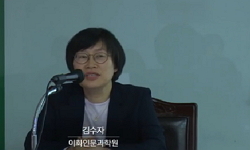This paper aims to determine the way of female communication and to describe female`s taste for narratives. Also it will discuss the pleasure female readers get from reading narratives such as novels or non-fictions. To reach this aims, the paper is g...
http://chineseinput.net/에서 pinyin(병음)방식으로 중국어를 변환할 수 있습니다.
변환된 중국어를 복사하여 사용하시면 됩니다.
- 中文 을 입력하시려면 zhongwen을 입력하시고 space를누르시면됩니다.
- 北京 을 입력하시려면 beijing을 입력하시고 space를 누르시면 됩니다.
https://www.riss.kr/link?id=A101990102
- 저자
- 발행기관
- 학술지명
- 권호사항
-
발행연도
2009
-
작성언어
Korean
-
주제어
『여성』 ; 『女性』 ; 실화 ; 여성 독자 ; 여성 독자의 취향 ; 여성적 소통 방식 ; 여성지 ; 일기 ; 편지 ; 해석적 규약 ; Diary ; Female Reader ; Letter ; Non-Fiction ; Pact of Interpretation ; Taste of Female Reader ; Way of Female Communication ; Women`S Magazine ; Yeo-Sung
-
KDC
810
-
등재정보
KCI등재
-
자료형태
학술저널
-
수록면
101-135(35쪽)
-
KCI 피인용횟수
8
- 제공처
-
0
상세조회 -
0
다운로드
부가정보
다국어 초록 (Multilingual Abstract)
This paper aims to determine the way of female communication and to describe female`s taste for narratives. Also it will discuss the pleasure female readers get from reading narratives such as novels or non-fictions. To reach this aims, the paper is going to analyze the women`s magazine, Yeo-Sung(女性), which was published in 1930s. There was much interaction between literary producers(writers) and consumer(readers) through women`s magazine, more than other media form. It is because, in the case of women`s magazine, the editors have to be more conscious about female readers` taste for narratives. The study would reach the following conclusions. First, non-fiction is the favorite narrative form of female readers. Actually, a certain narrative can become a non-fiction through a special device such as using the first-person narrator or real name. Diary and letters, which use these devices, also can belong to non-fiction. Editors of Yeo-Sung(女性) tended to carry diary or letters of unknown readers or professional writers. By reading non-fiction narratives, such as diary or letters, women readers can get intensive fantasy as if they are one of the characters in the narratives. They sympathize with the other women, thinking that the story is a `real` thing. Another conclusion is each novel, which was written by a professional writer, reflected and satisfied directly or indirectly the desires of two different female groups-women of upper classand women of lower class. While female students and house wives belonged to upper class, waitressesand(女給) and gisaengs(妓生), who were neglected in society, belonged to lower class women. They consisted the readers of Yeo-Sung(女性). Through the experience of reading novels, female readers could get pleasures depending on their own class but editors of Yeo-Sung(女性) carried the narratives that were suitable for general women`s preference. Therefore, the difference or conflict between two groups of female readers wasn`t a conspicuous thing.
참고문헌 (Reference)
1 "女性" 朝鮮日報社 1936
2 박혜숙, "한국여성의 자기서사(3):근대편" 한국여성문학학회 (9) : 233-274, 2003
3 박혜숙, "한국여성의 자기서사(2)" 한국여성문학학회 (8) : 306-328, 2002
4 박혜숙, "한국여성의 자기서사(1)" 한국여성문학학회 (7) : 323-349, 2002
5 이민희, "조선의 베스트셀러-조선후기 세책업의 발달과 소설의 유행" 프로네시스 1-183, 2007
6 Lejeune, P., "자서전의 규약" 문학과지성사 1-424, 1998
7 이정희, "여성의 고백담과 근대체험" 경희대 비교문화연구소 (5) : 103-116, 2002
8 장미영, "여성 자기서사의 서사적 특성연구-『여원』수기를 중심으로" 한국여성문학학회 18 (18): 161-194, 2007
9 서지영, "식민지 시대 카페 여급 연구 - 여급 잡지 『女聲』을 중심으로 -" 한국여성학회 19 (19): 31-73, 2003
10 서지영, "식민지 시대 기생 연구(Ⅲ)―기생 잡지 <長恨>을 중심으로―" 대동문화연구원 (53) : 347-385, 2006
1 "女性" 朝鮮日報社 1936
2 박혜숙, "한국여성의 자기서사(3):근대편" 한국여성문학학회 (9) : 233-274, 2003
3 박혜숙, "한국여성의 자기서사(2)" 한국여성문학학회 (8) : 306-328, 2002
4 박혜숙, "한국여성의 자기서사(1)" 한국여성문학학회 (7) : 323-349, 2002
5 이민희, "조선의 베스트셀러-조선후기 세책업의 발달과 소설의 유행" 프로네시스 1-183, 2007
6 Lejeune, P., "자서전의 규약" 문학과지성사 1-424, 1998
7 이정희, "여성의 고백담과 근대체험" 경희대 비교문화연구소 (5) : 103-116, 2002
8 장미영, "여성 자기서사의 서사적 특성연구-『여원』수기를 중심으로" 한국여성문학학회 18 (18): 161-194, 2007
9 서지영, "식민지 시대 카페 여급 연구 - 여급 잡지 『女聲』을 중심으로 -" 한국여성학회 19 (19): 31-73, 2003
10 서지영, "식민지 시대 기생 연구(Ⅲ)―기생 잡지 <長恨>을 중심으로―" 대동문화연구원 (53) : 347-385, 2006
11 천정환, "근대의 책읽기-독자의 탄생과 한국 근대문학" 푸른역사 1-563, 2003
12 Brooks, P, "Reading for the Plot" Harvard Univ. Press 1-363, 1992
13 노지승, "1920년대 초반, 편지 형식 소설의 의미 사적 영역의 성립 및 근대적 개인의 탄생 그리고 편지 형식 소설과의 관련에 대하여" 민족문학사학회 20 (20): 351-381, 2002
동일학술지(권/호) 다른 논문
-
- 한국현대소설학회
- 김현숙
- 2009
- KCI등재
-
- 한국현대소설학회
- 김상태(Sang Tae Kim)
- 2009
- KCI등재
-
- 한국현대소설학회
- 임기현(Gi Hyeon Im)
- 2009
- KCI등재
-
- 한국현대소설학회
- 박상준(Sang Joon Park)
- 2009
- KCI등재
분석정보
인용정보 인용지수 설명보기
학술지 이력
| 연월일 | 이력구분 | 이력상세 | 등재구분 |
|---|---|---|---|
| 2026 | 평가예정 | 재인증평가 신청대상 (재인증) | |
| 2020-01-01 | 평가 | 등재학술지 유지 (재인증) |  |
| 2017-01-01 | 평가 | 등재학술지 유지 (계속평가) |  |
| 2013-01-01 | 평가 | 등재학술지 유지 (등재유지) |  |
| 2010-01-01 | 평가 | 등재학술지 유지 (등재유지) |  |
| 2008-01-01 | 평가 | 등재후보 1차 FAIL (등재후보1차) |  |
| 2006-01-01 | 평가 | 등재학술지 유지 (등재유지) |  |
| 2003-01-01 | 평가 | 등재학술지 선정 (등재후보2차) |  |
| 2002-01-01 | 평가 | 등재후보 1차 PASS (등재후보1차) |  |
| 2000-07-01 | 평가 | 등재후보학술지 선정 (신규평가) |  |
학술지 인용정보
| 기준연도 | WOS-KCI 통합IF(2년) | KCIF(2년) | KCIF(3년) |
|---|---|---|---|
| 2016 | 0.6 | 0.6 | 0.6 |
| KCIF(4년) | KCIF(5년) | 중심성지수(3년) | 즉시성지수 |
| 0.6 | 0.63 | 1.017 | 0.15 |




 DBpia
DBpia



